#writhe billed hornbill
Explore tagged Tumblr posts
Text
Loser's Bracket, Poll 9




Image Sources: Nuthatch (Arpit Bansal); Macaw (eraserdustart); Trogon (John Missing); Hornbill (Lorenzo Vinciguerra)
#hipster bird losers bracket#beautiful nuthatch#glaucous macaw#white-tailed trogon#writhe billed hornbill#polls
16 notes
·
View notes
Text
Iloilo town's wildlife park breeds endangered bird
#PHnews: Iloilo town's wildlife park breeds endangered bird
ILOILO CITY – A newly-bred writhed-billed hornbill, considered as the world’s second most critically endangered hornbill, has given hope to its kind when it finally flew last week while in captivity inside the Mari-it Wildlife and Conservation Park in Barangay Jayubo in Lambunao town, Iloilo.
Dr. JB Ian G. Bullo, Veterinarian 2 of the West Visayas State University-College of Agriculture and Forestry (WVSU-CAF) and assigned at the park, said that the male chick hornbill got out from the nest on December 28, 2020 and was able to flap its wings and fly on January 10.
“It took around one and half-month before we heard chirps from the newborn chick,” he said in a phone interview on Friday.
Only one pair was able to breed and only one egg was laid and hatched, he said.
The Park has 15 birds of this species also known as “dulungan” or the Visayan wrinkled hornbill.
The bird is monogamous and its mate serves as its partner for life.
The breeding period of hornbills usually starts every September. It is the male that prepares the nest.
“Losing their partner will greatly affect breeding as they will not breed with other birds that they are not compatible with. When the female starts to lay eggs, it will seal itself in a hollow tree trunk and rely on the male partner to feed her and the future chick. If the male is killed while the female is still sealed together with its chick, they may suffer and die due to hunger,” he added.
Currently, they are still observing the new chick if it is independent enough to collect its own food. While it can already fly, it still relies on its parents for food.
Bullo said usually it will take a month, after leaving the nest, that the chick can already be separated from its parents.
They plan to name the hornbill as "Bebong" after the current president of the university.
The veterinarian said that the support extended by the university, local government unit of Lambunao, the Department of Environment and Natural Resources (DENR), and the Talarak Foundation Inc., helped a lot in the successful breeding of the bird.
He recalled that on his first year at the park in 2018, a pair aborted breeding. It was suspected that the failed breeding was due to nutrition issues.
A female chick was hatched in 2019 but it died after two months. The necropsy showed the chick had an injury on its left hind limb and there were signs of gastrointestinal problems.
“We were not able to place the best ration and nest as we are still constricted by financial concerns so we have to make use of what we have. Our goal is to satisfy both the nutritional and environmental requirement, as close as possible, to the optimum condition while being economical,” he said.
He added that this time, they are fortunate to have successful breeding; the chick left its nest alive and showed no visible deformities or signs of disease.
The last successful breeding inside the center was in 2011, a female hornbill, he said.
As breeding the endangered bird is delicate, Bullo said that they need all the help they could get to ensure its success. “We need to give the birds optimum rations and facilities not only during the breeding season but whole year-round in order for the birds to stay in the right condition to breed again. Operating expense remains the biggest hurdle of the center and help of any kind is very much welcome,” he said.
Meantime, Lambunao tourism officer Jennifer Osorio said that apart from the support from the local government unit, the quarantine period has helped a lot because their environment was not disturbed.
“Somehow our endangered species were also stressed every time there are visitors,” she said.
Since the season for breeding is over and the restrictions have relaxed a bit, Osorio said that the park is already open and visitors can view the baby hornbill.
However, health protocols such as wearing face masks, logging in and out, and stepping on a foot bath for disinfection must be observed.
Mari-it (enchanted) is the first conservation, breeding, and rescue park in Panay Island. It is situated in a 1,000-hectare lot within the 3,000-hectare campus of the WVSU-CAF in Barangay Jayubo, some 16 kilometers away from the town of Lambunao.
Apart from the Visayan writhed hornbill and endangered Visayan tarictic hornbill, the park also hosts the endangered Visayan spotted deer; critically endangered Visayan warty pig; vulnerable Visayan leopard cat, and the cloud rat, among others.
The wildlife and conservation park is being promoted as an eco-tourism site having two springs and rich flora and fauna. (PNA)
***
References:
* Philippine News Agency. "Iloilo town's wildlife park breeds endangered bird." Philippine News Agency. https://www.pna.gov.ph/articles/1127475 (accessed January 15, 2021 at 10:34PM UTC+14).
* Philippine News Agency. "Iloilo town's wildlife park breeds endangered bird." Archive Today. https://archive.ph/?run=1&url=https://www.pna.gov.ph/articles/1127475 (archived).
0 notes
Text
Round 1, Poll 38
Red-crested Turaco vs Writhe-billed Hornbill

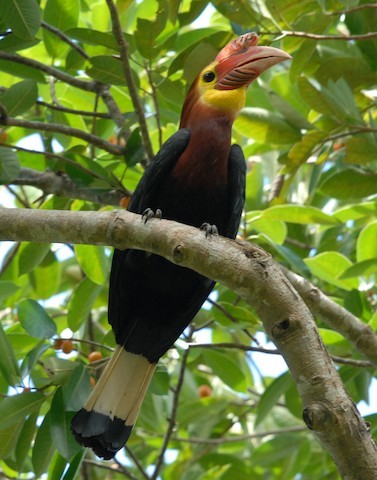
sources under cut
Red-crested Turaco Propaganda
eBird Sightings - 106
IUCN Status - Least Concern
Location: Africa - Northwest Angola
"looks like a mango"
Writhe-billed Hornbill Propaganda
eBird Sightings - 31
IUCN Status - Critically Endangered
Location: Philippines - Panay and Negros islands
Thought to be rare even before human disruption, this species is now suffering from extensive cutting and logging of its lowland forest habitat. It was also a victime of hunting and nest robbing for the pet trade, though local efforts have reduced nest poaching by 95%.
Image Sources: Turaco (Dubi Shapiro); Hornbill (Lorenzo Vinciguerra)
Other Sources: Birds of the World
#hipster bird main bracket#bracket: true a#poll#polls#round 1#red crested turaco#writhe billed hornbill
11 notes
·
View notes
Text
BRACKET A: FAVES
Pinyon Jay, Bridled Titmouse, Kirtland's Warbler, Dusky Seaside Sparrow, Gray Catbird, Gray Vireo, Rook, Smooth-billed Ani, Toulouse Goose, Pygmy Nuthatch, Blue Nuthatch, Rufous-collared Sparrow, Prothonotary Warbler, Channel-billed Cuckoo, Short-eared Owl, Whiskered Treeswift, Green Catbird, American Dipper, Common Ground Dove, Oilbird, Yellow-billed Magpie, Ferruginous Hawk, Grey warbler [Riroriro], African Penguin, Blakiston’s Fish Owl, Lesser Roadrunner, Great Bustard, European Pied Flycatcher, Bonin Petrel, Band-tailed Manakin, Pallas Sandgrouse, White-throated Magpie-Jay
BRACKET B: TRUE
Regent Honeyeater, Invisible Rail, Palawan Peacock-pheasant, Bald Parrot, Kagu, Azores Bullfinch, Capuchinbird, Zigzag Heron, Writhe-billed Hornbill, Blue-Capped Ifrita, Delalande's coua, Madagascar Ibis, Blue-headed Racquet-tail, Eurasian Three-toed Woodpecker, Glaucous Macaw, Goldie's Bird-of-Paradise, Red-Crested Turaco, Palau Kingfisher, Ribbon-tailed Astrapia, Great Argus, Kaua'i Mole Duck, Whiskered Auklet, Dulit Frogmouth, Naked-faced Barbet, Pink-throated Twinspot, Water Thick-Knee, Cabot's Tragopan, White-tailed Ptarmigan, Collared Nightjar, Sickle-winged Nightjar, Emerald Starling, Starry Owlet-nightjar
BRACKET C: PRETTY
Gouldian Finch, Violet Turaco, Red-tailed Black Cockatoo, Pompadour Cotinga, Pheasant-tailed Jacana, Wilson's Bird-of-Paradise, Purple-crowned Fairy, Painted Redstart, Western Bluebird, Golden Pheasant, Beautiful Nuthatch, Ochre-backed Woodpecker, Chucao Tapaculo, Bohemian Waxwing, Plumed Whistling-Duck, Lady Amherst's Pheasant, Bluethroat, Southern Emuwren, Shaft-tailed Whydah, Green Wood-Hoopoe, Plumbeous Redstart, Long-tailed Minivet, Japanese Paradise flycatcher, Purple Glossy Starling, Willie-Wagtail, Pink-necked Green Pigeon, Purple Honeycreeper, Red-cheeked Cordonbleu, Varied Bunting, Bearded Mountaineer, Scaled Fruiteater, Pink Robin
BRACKET D: FOUR
Hamerkop, Malayan Night-heron, Common Nighthawk, Powerful Owl, Short-tailed Pygmy-tyrant, Black-necked Grebe, Javan Myna, Dickcissel, Silver Teal, Streaked Weaver, Speckled Mousebird, Wedge-tailed Eagle, Jackal Buzzard, Bat Hawk, White-bellied Chachalaca, Bell Miner, Oriental Bay-Owl, European Shag, White-winged Tern, Ancient Murrelet, Helmeted Hornbill, Arabian Babbler, Oriental Stork, Bearded Bellbird, Seaside Cinclodes, Groove-billed Ani, Marvelous Spatuletail, Yellow-collared Macaw, Spotted Forktail, Hairy Hermit Hummingbird, White-tailed Trogon, Fiery-billed Aracari
Main Brackets!
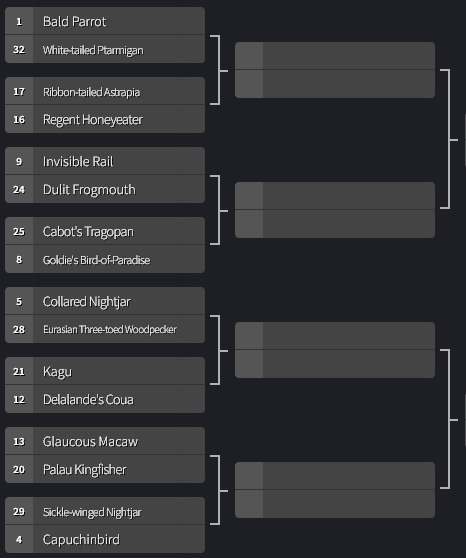
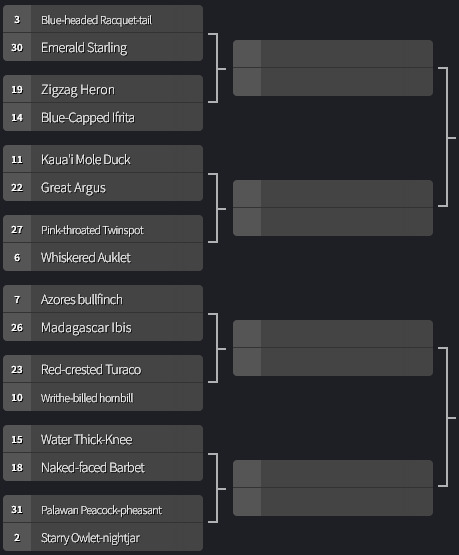

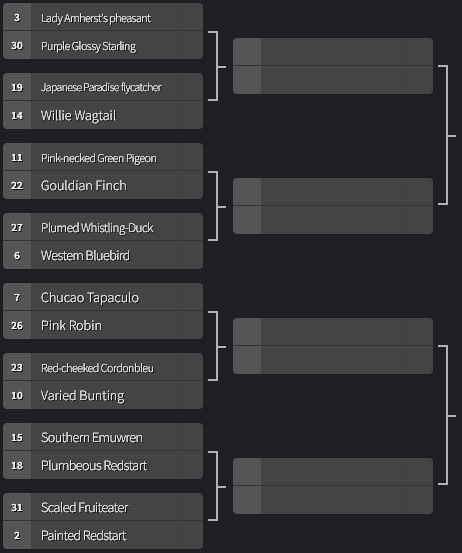
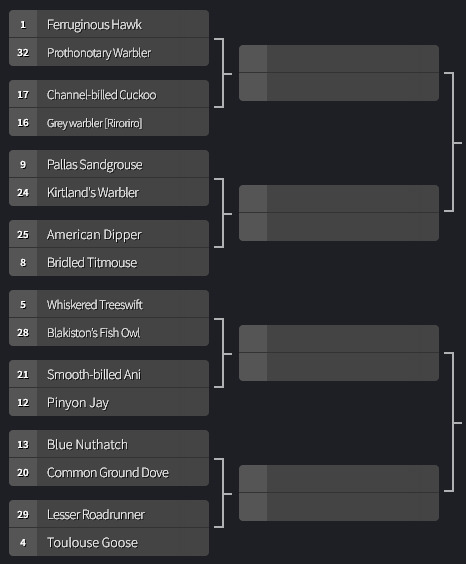
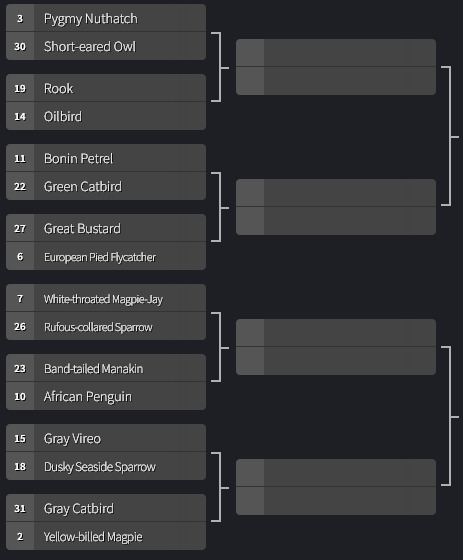

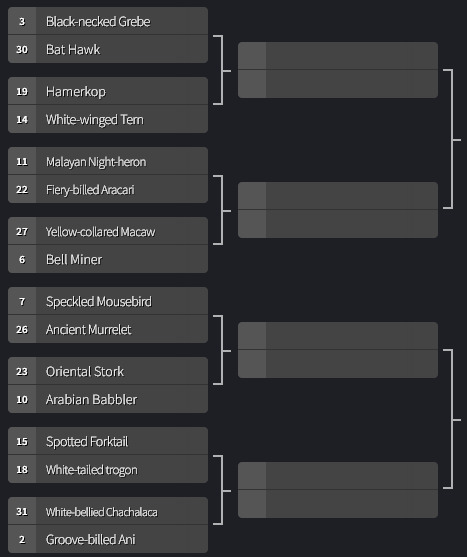
There are four brackets [Fave, Pretty, True, Four] comprising of 32 birds, for a total of 128 birds in this poll! I will reblog a version of this post with every bird listed via text within their bracket, so it is easier to find for those with image issues. It's gonna take a while to actually put the posts together for the first round, seeing as there are 64 battles happening, so expect the polls to go up around July 12th.
Below is a link for submitting any cool facts or info about the birds you want to win. It's not necessary to send info here, but I like to give the option to infodump about birds, and it helps with keeping things organized. As a heads up, the submission box is capped at one response only (with up to three birds in said response) just to keep things from getting cluttered.
As per tumblr etiquette, you are totally free to reblog the polls themselves with as much propoganda as you want. These submissions are just to help me fill the poll post with some cool facts.
54 notes
·
View notes
Text
Hey these birds were submitted without the reason/propoganda section filled out, so if you think theyre cool or know any cool facts please feel free to submit something to the link above! (Also-- I removed the submission limit for the poll. I forgot to edit the above post before reblogging this.)
White-throated Magpie-Jay
Lesser Roadrunner
Ferruginous Hawk
Bald Parrot
Blue-headed racquet-tail
Writhe-billed hornbill
Naked faced barbet
Collared nightjar
Sickle-winged nightjar
Emerald starling
Starry owlet-nightjar
Purple Glossy Starling
Varied Bunting
Bearded Mountaineer
Scaled Fruiteater
Fiery-billed Aracari
Spotted Forktail
Marvelous Spatuletail
Bearded Bellbird
White-bellied Chachalaca
Main Brackets!








There are four brackets [Fave, Pretty, True, Four] comprising of 32 birds, for a total of 128 birds in this poll! I will reblog a version of this post with every bird listed via text within their bracket, so it is easier to find for those with image issues. It's gonna take a while to actually put the posts together for the first round, seeing as there are 64 battles happening, so expect the polls to go up around July 12th.
Below is a link for submitting any cool facts or info about the birds you want to win. It's not necessary to send info here, but I like to give the option to infodump about birds, and it helps with keeping things organized. As a heads up, the submission box is capped at one response only (with up to three birds in said response) just to keep things from getting cluttered.
As per tumblr etiquette, you are totally free to reblog the polls themselves with as much propoganda as you want. These submissions are just to help me fill the poll post with some cool facts.
#yes I am outsourcing labor but its all voluntary#I've still gotta do my own photos and info grabbing#its just taking a lot longer than I thought it would...
54 notes
·
View notes